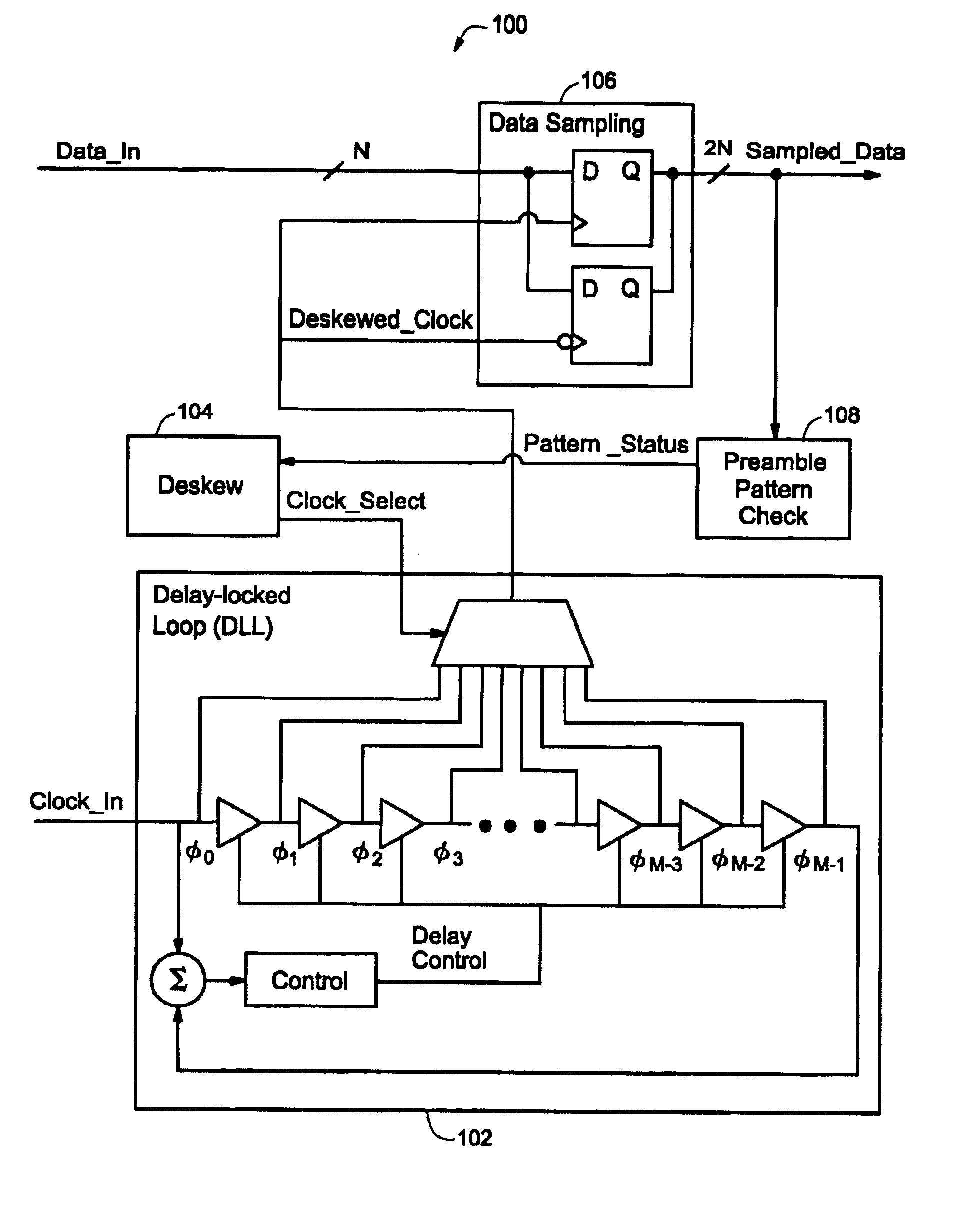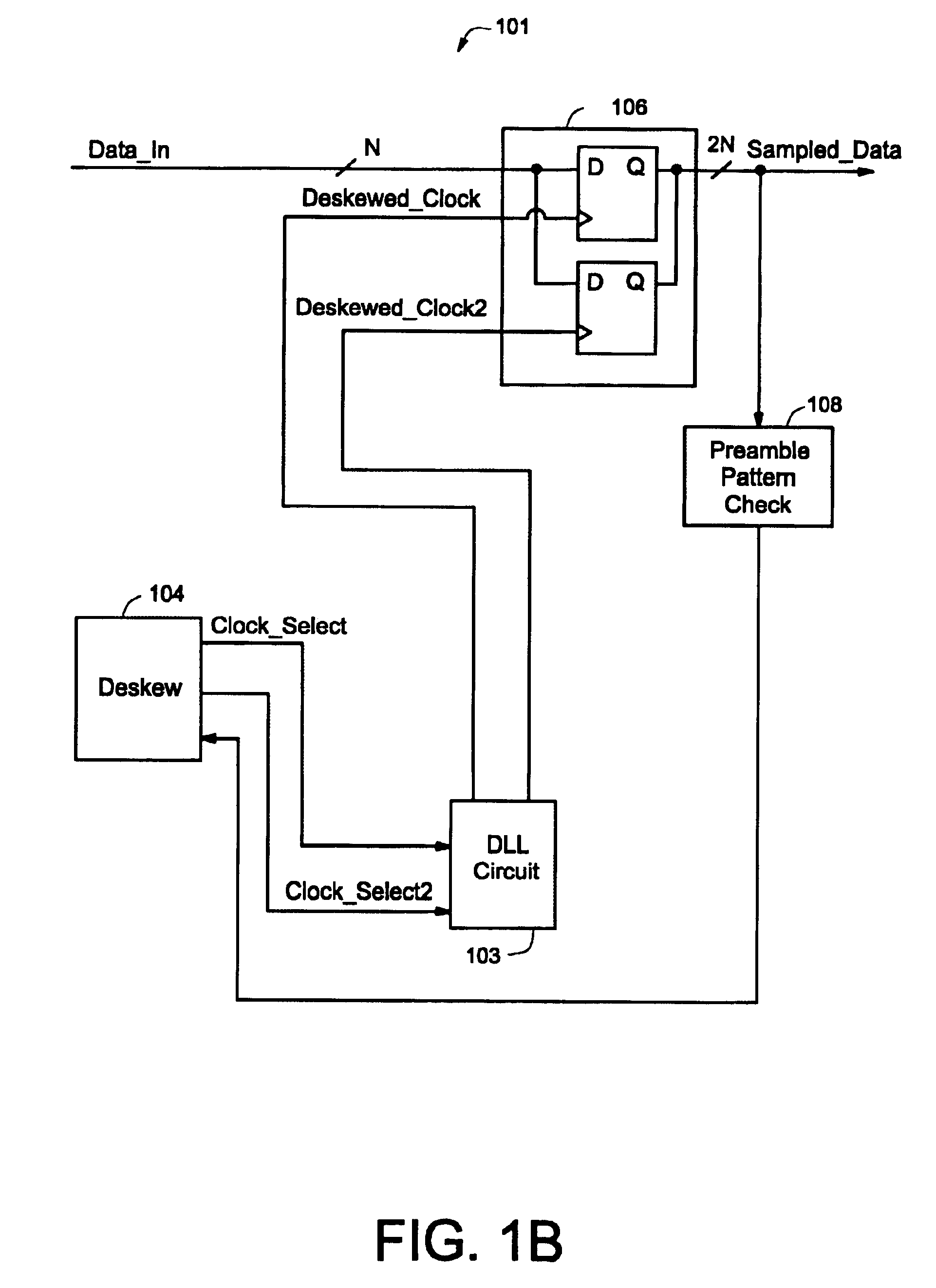Clock deskew protocol using a delay-locked loop
a delay-locked loop and clock technology, applied in the field of clock deskewing, can solve the problems of non-ideal skew between data transmission and clock signal, limited maximum reliable transmission speed between transmitter and receiver, and non-ideal skew
- Summary
- Abstract
- Description
- Claims
- Application Information
AI Technical Summary
Problems solved by technology
Method used
Image
Examples
example protocol
FIG. 3 is an illustration of a timing diagram for an example data frame protocol. As described previously, the system is operated over two basic time intervals that makeup the data frame transmission cycle.
An adjustment time interval is utilized to attend to various overhead and synchronization of the sampling clock prior to “live” data sampling. The “live” data sampling is subsequently performed in a data sampling time interval. The overhead portion of the adjustment time interval can be used for various configuration functions. An example system may have an adjustment time interval that comprises 5% of the data frame transmission cycle. Other example systems may comprises more or less than 5% of the data frame transmission cycle.
The example data protocol illustrated in FIG. 3 includes an adjustment time interval that is broken into three constituent parts: a Header interval, an Execute Deskew interval, and a DLL Loop Update interval. The DLL Loop Update interval may be used by cir...
example deskew
Methodology
FIG. 5 is an illustration of a flow diagram (500) for an example deskewing methodology. The methodology is broken into three phases: a skew checking phase (501), a failure checking phase (502), and a clock selection phase (503).
The skew checking phase (501) is performed for each of the available clock signals (i.e., the clock phases) during different Execute Deskew intervals. During the skew checking phase, data is sampled using the selected clock signal, and the sampled data is compared to the desired preamble pattern for accuracy. The skew checking phase also decides which clock signals correspond to the first and last passing phases for the sampled data. The failure checking phase (502) is arranged to reevaluate the last selected clock signal and decide whether the system is properly operating as a failsafe check. The clock selection phase (503) is arranged to select the appropriate clock signal based on historical data and the results of the skew checking phase (501) ...
example midpoint
Filtering Methology
Processing for the example midpoint filtering method begins at start block 602. Processing then proceeds from start block 602 to block 604. At block 604, FILTER_COUNT is initialized to zero. Processing then proceeds from block 604 to block 606. At block 606, process 548 waits for the end of the DDA cycle. Processing then proceeds from block 606 to decision block 608. At decision block 608, process 548 evaluates whether MIDPOINT is greater than DESKEW_PHASE. Processing proceeds from decision block 608 to decision block 610 when MIDPOINT is greater than DESKEW_PHASE. Alternatively, processing proceeds from decision block 608 to decision block 615 when MIDPOINT is not greater than DESKEW_PHASE. At decision block 615, process 548 evaluates whether MIDPOINT is less than DESKEW_PHASE. Processing proceeds from decision block 615 to decision block 616 when MIDPOINT is less than DESKEW_PHASE. Alternatively, processing proceeds from decision block 615 to decision block 622 ...
PUM
 Login to View More
Login to View More Abstract
Description
Claims
Application Information
 Login to View More
Login to View More - R&D
- Intellectual Property
- Life Sciences
- Materials
- Tech Scout
- Unparalleled Data Quality
- Higher Quality Content
- 60% Fewer Hallucinations
Browse by: Latest US Patents, China's latest patents, Technical Efficacy Thesaurus, Application Domain, Technology Topic, Popular Technical Reports.
© 2025 PatSnap. All rights reserved.Legal|Privacy policy|Modern Slavery Act Transparency Statement|Sitemap|About US| Contact US: help@patsnap.com



